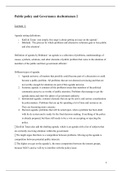Samenvatting
Summary Public policy and governance partial exam/deeltentamen 2
This is a summary for the public policy and governance partial exam two (for the Dutch & English track). I passed this exam with a 9,0 (best grade of the entire course), so I'm sure this summary will help you as well. The summary includes notes of the lectures, which are added/enhanced with the wee...
[Meer zien]














